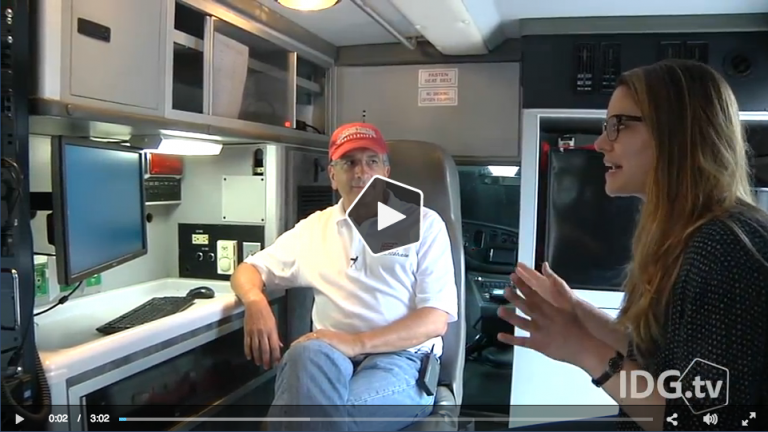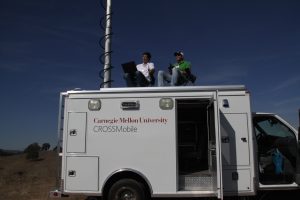
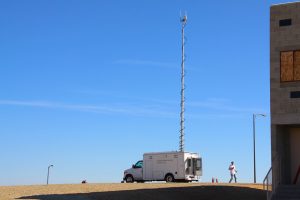
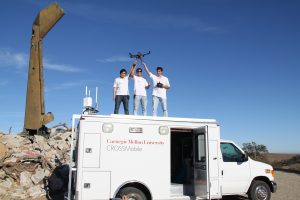
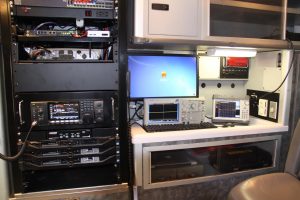
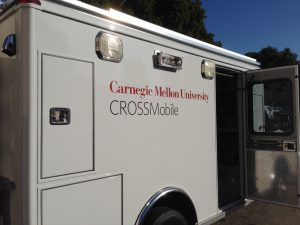
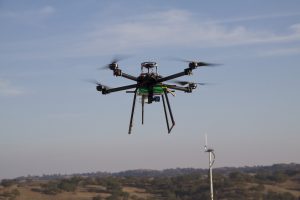
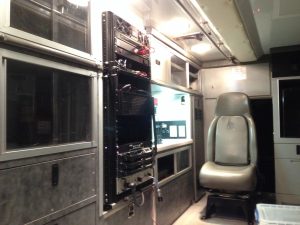
The CROSSMobile Van
Why?
Connecting theory to practice for wireless networks requires a substantial investment in lab facilities. But even so, the more interesting studies involve real topographies, real antennas, and real user equipment with real users. Bridging the gap often involves extensive planning, logistics and setup to create a real network in the field.
What?
The CROSSMobile project at CMU’s Silicon Valley campus includes an on-campus cellular network testbed, supporting experimentation at all levels of networks. In addition to this fixed network, we’ve designed and built a mobile RF laboratory that allows us to take this capability into the field — with the ability to create, run, instrument and study cellular, WiFi, and narrowband networks. This mobile lab also includes local compute servers, a satellite ground station and a stand-alone power plant that give us the opportunity to create a full mobile network wherever we go.
We created the concept for our mobile lab by studying emergency communications vehicles that other organization had assembled. We observed that many, if not most, were designed to house many traditional fixed-band radios. Using the software-defined mobile network approach that we applied to our on-campus network, we built the mobile lab using software-defined radios and software-defined networking. All of the core computing, including the software-defined radios themselves, run within a unified virtualization environment in the van. This same environment supports both virtualized network functions as well as service machines — a local computing cloud — that is integrated with the wireless network. This integration and flexibility make it straightforward to configure the van for different applications. Drone-based data collection and real-time visualization use the same infrastructure as our Survivable Social Network (an emergency communications service).
How?
Our van began its life as an honest-to-goodness ambulance for the City of Los Angeles. We selected an ambulance as our vehicle of choice because it provides multiple power sources (alternator, shore power, battery), some natural places for equipment (more on that below), storage space for equipment, and decent creature comforts.
Re-fitting the ambulance involved putting in a shock-mounted equipment rack where one of the paramedics used to sit (see the photo on the right), putting in a 42-foot pneumatic antenna mast where the oxygen bottle used to go, creating a full roof walk with ladder, making it easy to attach various fixtures to the top of the mast, and filling the rack with networking and computing equipment.
Capabilities
The van is currently outfitted to provide four access networks supported by three backhaul networks, undergirded by four power sources.
Access Network
- Our software-defined LTE network that is band-agile
- A mast-mounted WiFi access point for 2.4 / 5 GHz WiFi coverage
- A Motorola XPR8300 repeater, providing DMR (digital mobile radio) coverage. This repeater is also connected to the internet through our soft switch. With a live internet connection, our DMR handheld radios can access the worldwide DMR network
- A low-power, wide-area network (LP-WAN) using LoRa radios
Backhaul Network
- The van can re-link to the internet four different ways: via a multi-operator cellular router, by WiFi (if available), by wired ethernet, or via an Inmarsat ground station. Flexible, software-defined routing allows our van to inter-network with other in-the-field networks as well.
Power Sources
- A high-capacity alternator
- Three marine batteries
- A shore power inlet and charger
- A backup gasoline generator
Computing
- Onboard rackmounted servers, virtualized with Xen
Field trials
The van is in regular use for field experiments at Camp Roberts, CA (including Field Experiments sponsored by the Naval Postgraduate School — NPS-FX), providing communications, computation, and flight operations support for our drone fleet. The van has also made guest appearances at emergency preparedness events and is in regular use on and around campus.

